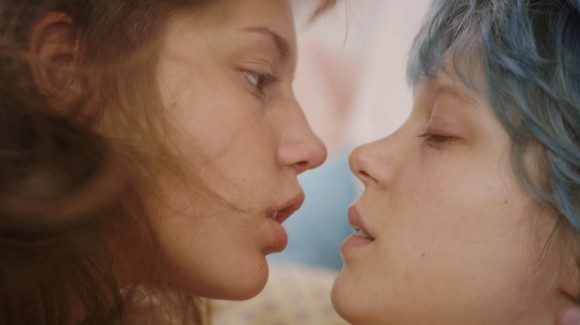The French romantic drama Blue is the Warmest Color (La vie d’Adéle) is surely adept at capturing headlines. Ever since the provocative, nearly three-hour-long movie won the top prize at this years Cannes Film Festival, a wave of criticism and controversy has fallen on the film that tells the story of two girls in the throes of a youthful romance. And now comes word, that Blue, which was picked up for domestic release by Sundance Selects, has been slapped with a restrictive NC-17 rating.
The film, based on the comic by Julie Maroh and directed by Abdellatif Kechiche (The Secret of the Grain) won the Palme D’Or this past May at the Cannes from a jury headed by Steven Spielberg. The French film stars up and coming actresses Adéle Exarchopoulos and Léa Seydoux (who American audiences may recognize from bit parts in Midnight in Paris, Mission: Impossible- Ghost Protoctol, and Inglourious Basterds; Seydoux will also appear in Wes Anderson’s upcoming The Grand Budapest Hotel) and was a talking point of critics for the films graphic, nearly twenty minute sex scene. Some argued the films artfulness made the scene necessary, while others cried foul, thinking it was exploitative and perhaps inappropriate male fantasy from heterosexual Kechiche. Either way the scene itself was the reasoning behind its restrictive rating.
All of which gives Sundance three options: edit the film in an effort to secure a R rating and sideswipe the potential stigma that comes with a NC-17 rating (for instance, some movie chains won’t play films with that rating and media outlets won’t allow advertising for NC-17 rated films), release the film unrated, or accept the MPAA ruling. They appear to going for the latter. Sundance Selects/IFC Films president Jonathon Sehring commented, “This is a landmark film with two of the best female performances we have ever seen on screen,” and, “The film is first and foremost a film about love, coming of age and passion. We refuse to compromise Kechiche’s vision by trimming the film for an R rating. … An NC-17 rating no longer holds the stigma it once did.”
The NC-17 rating was introduced by the Motion Picture Association of America in 1990 as an effort to reduce the stigma that it’s previous incarnation – the ‘X’ rating held – in hopes of offering a differentiation between art films containing adult themes versus pornography. The first film to given a NC-17 was 1990’s Henry & June, still the only film with the restrictive rating to have been nominated for an Academy Award. Kill recent films like Shame (2011), Killer Joe (2012) and The Dreamers (2004) have all wore their restrictive ratings as a badge of honor and managed to become art-house success stories, neither film broke out into the mainstream at the box office, or were acknowledged with Oscar nominations. Blue Valentine (2010) was famously rated NC-17 on its first try, only to be later successfully appealed by Harvey Weinstein in a grand-mastering of public relations.
Sundance Selects, which is hoping to garner awards interest for Exarchopoulos and Seydoux may find themselves in a different sort of situation, considering the interest the film has ranged with all of the talk of sexual content, but forges on uphill battle on terms of profitability and an potential awards appearance. Strangely, considering its high profile, hype and Cannes victory, France will not choose Blue is the Warmest Color as it’s selection for Best Foreign Language Film. The film is being released in France after the deadline for submission. Either way, Blue will hit limited release in the United States October 25th, right on the heels of it’s presence (and perhaps added controversy stirred) at the major fall film festivals.


